The Siberian tiger and Bengal tiger subspecies rank among the biggest living cats.[5][6] An average adult male Siberian outweighs an average adult male lion by around 45.5 kg (100 lb).[7] A comparison of data on body weights of Siberian tigers indicates that up to the first half of the 20th century both males and females were on average heavier than post-1970 ones. Today's wild Siberian tigers are smaller than Bengal tigers. Their reduced weight as compared to historical Siberian tigers may be due to a combination of causes: when captured, they were usually sick or injured and involved in a conflict situation with people.[8]
Results of a phylogeographic study comparing mitochondrial DNA from Caspian tigers and living tiger subspecies indicate that the common ancestor of the Amur and Caspian subspecies colonized Central Asia from eastern China via the Gansu−Silk Road corridor from eastern China, and then subsequently traversed Siberia eastward to establish the Amur tiger population in the Russian Far East.[9]
Characteristics
Captive Siberian tiger
A Siberian tigress
Body size

The largest male, with largely assured references, measured 350 cm (140 in) "over the curves", equivalent to 330 cm (130 in) "between the pegs". The tail length in fully grown males is about 1 m (39 in). Weights of up to 318 kg (701 lb) have been recorded and exceptionally large males weighing up to 384 kg (847 lb) are mentioned in the literature, but according to Mazák, none of these cases can be confirmed via reliable sources.[11] Mazák indicates the typical weight range of Siberian tigers as 180–306 kg (397–675 lb) for males and 100–167 kg (220–368 lb) for females.[5]
Exceptionally large individuals were targeted and shot by hunters.[12] An unconfirmed report tells of a male tiger shot in the Sikhote-Alin Mountains in 1950 weighing 384 kg (847 lb) with an estimated length of 3.48 m (11.4 ft). In some cases, captive Siberian tigers reached a body weight of up to 465 kg (1,025 lb), such as the tiger "Jaipur."[13]
Measurements taken by scientists of the Siberian Tiger Project in Sikhote-Alin range from 200–450 cm (79–177 in) in head and body length measured in straight line, with an average of 195 cm (77 in) for males; and for females ranging from 167 to 182 cm (66 to 72 in) with an average of 174 cm (69 in). The average tail measures 99 cm (39 in) in males and 91 cm (36 in) in females. The longest male measured 309 cm (122 in) in total length (tail of 101 cm (40 in)) and had a chest girth of 127 cm (50 in). The longest female measured 270 cm (110 in) in total length (tail of 88 cm (35 in)) and had a chest girth of 108 cm (43 in). These measurements show that the present Amur tiger is longer than the Bengal tiger and the African lion.[14]
In 2005, a group of Russian, American and Indian zoologists published an analysis of historical and contemporary data on body weights of wild and captive tigers, both female and male across all subspecies. The data used include weights of tigers that were older than 35 months of age and measured in the presence of authors. The results of this analysis indicates that the average historical wild male Siberian tiger weighed 215.3 kg (475 lb) and the female 137.5 kg (303 lb); the contemporary wild male Siberian tiger weighs 176.4 kg (389 lb) on average with an asymptotic limit being 222.3 kg (490 lb); a wild female weighs 117.9 kg (260 lb) on average. Historical Siberian tigers and Bengal tigers were the largest ones, whereas contemporary Siberian tigers are lighter than Bengal tigers, on average. The reduction of the body weight of today's Siberian tigers may be explained by concurrent causes, namely the reduced abundance of prey due to illegal hunting and that the individuals were usually sick or injured and captured in a conflict situation with people.[8] A male captured by members of the Siberian Tiger Project weighed 206 kg (454 lb), and the largest male radiocollared weighed 212 kg (467 lb).[15][16]
Skull

The skull of the Siberian tiger is characterized by its large size, and is similar to the skull of a lion. It differs in the structural features of the lower jaw and relative length of nasals. The facial region is very powerful and very broad in the region of the canines.[10] The skull prominences, especially sagittal crest and crista occipitalis are very high and strong in old males, and often much more massive than usually observed in the biggest skulls of Bengal tigers. The size variation in skulls of Siberian tigers ranges from 331 to 383 mm (13.0 to 15.1 in) in nine individuals measured. A female skull is always smaller and never as heavily built and robust as that of a male. The height of the sagittal crest in its middle part reaches as much as 27 mm (1.1 in), and in its posterior part up to 46 mm (1.8 in).[17]
Female skulls range from 279.7 to 310.2 mm (11.01 to 12.21 in). The skulls of male Turanian tigers from Turkestan had a maximum length of 297.0 to 365.8 mm (11.69 to 14.40 in), while that of females measured 195.7 to 255.5 mm (7.70 to 10.06 in). A tiger killed on the Sumbar River in Kopet-Dag in January 1954 had a greatest skull length of 385 mm (15.2 in), which is considerably more than the known maximum for this population and slightly exceeds that of most Siberian tigers. However, its condylobasal length was only 305 mm (12.0 in), smaller than those of the Siberian tigers, with a maximum recorded condylobasal length of 342 mm (13.5 in).[14] The biggest skull of a Siberian tiger from northeast China measured 406 mm (16.0 in) in length, which is about 20–30 mm (0.79–1.18 in) more than the maximum skull lengths achieved by tigers from the Amur region and northern India.[18]
Siberian tiger cub
Fur and coat
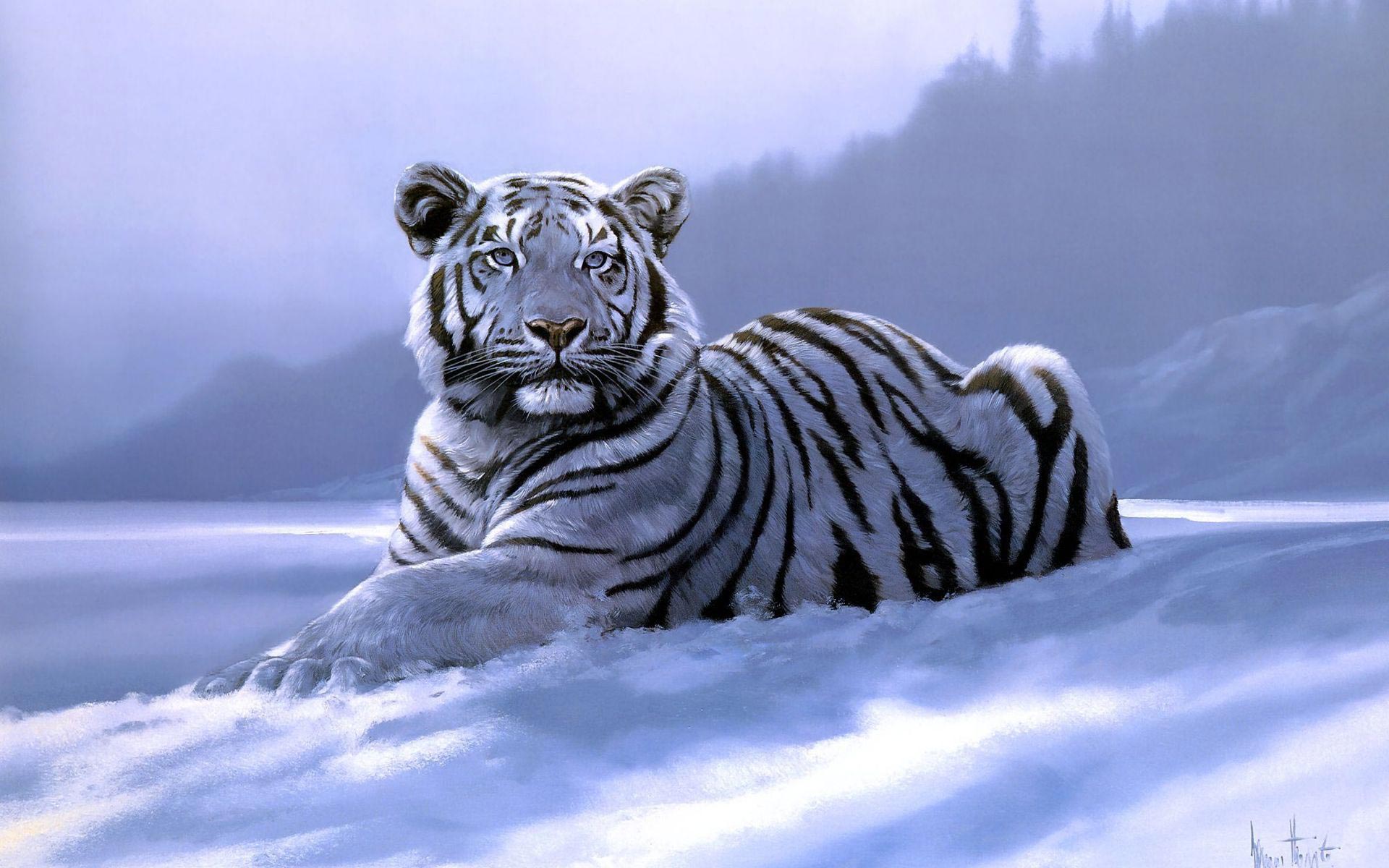
The ground colour of Siberian tigers' pelage is often very pale, especially in winter coat. However, variations within populations may be considerable. Individual variation is also found in form, length, and partly in colour, of the dark stripes, which have been described as being dark brown rather than black.[17]
The fur of the Siberian tiger is moderately thick, coarse and sparse compared to that of other felids living in the former Soviet Union. Compared to the now-extinct westernmost populations, the Far Eastern Siberian tiger's summer and winter coats contrast sharply with other subspecies. Generally, the coat of western populations was brighter and more uniform than that of the Far Eastern populations. The summer coat is coarse, while the winter coat is denser, longer, softer, and silkier. The winter fur often appears quite shaggy on the trunk, and is markedly longer on the head, almost covering the ears. The whiskers and hair on the back of the head and the top of the neck are also greatly elongated. The background color of the winter coat is generally less bright and rusty compared to that of the summer coat. Due to the winter fur's greater length, the stripes appear broader with less defined outlines. The summer fur on the back is 15–17 mm (0.59–0.67 in) long, 30–50 mm (1.2–2.0 in) along the top of the neck, 25–35 mm (0.98–1.38 in) on the abdomen, and 14–16 mm (0.55–0.63 in) on the tail. The winter fur on the back is 40–50 mm (1.6–2.0 in), 70–110 mm (2.8–4.3 in) on the top of the neck, 70–95 mm (2.8–3.7 in) on the throat, 60–100 mm (2.4–3.9 in) on the chest and 65–105 mm (2.6–4.1 in) on the abdomen. The whiskers are 90–115 mm (3.5–4.5 in).[10]
Distribution and habitat

The Siberian tiger once inhabited the Korean Peninsula, Manchuria and other parts of north-eastern China, the eastern part of Siberia and the Russian Far East, perhaps as far west as Mongolia and the area of Lake Baikal, where the Turan tiger also reportedly occurred.[10] The geographical range of Amur tigers in the Russian Far East stretches south to north for almost 1,000 km (620 mi) the length of Primorsky Krai and into southern Khabarovsk Krai east and south of the Amur River. They also occur within the Greater Xing'an Range, which crosses into Russia from China at several places in southwest Primorye. In both regions, peaks are generally 500 to 800 m (1,600 to 2,600 ft) above sea level, with only a few reaching 1,000 m (3,300 ft) or more. This region represents a merger zone of two bioregions: the East Asian coniferous-deciduous complex and the northern boreal complex, resulting in a mosaic of forest types that vary with elevation, topography, and history. Key habitats for the Amur tiger are Korean pine broadleaf forests with a complex composition and structure.[19]
The faunal complex of the region is represented by a mixture of Asian and boreal life forms. The ungulate complex is represented by seven species, with Manchurian wapiti, Siberian roe deer, and wild boar being the most common throughout the Sikhote-Alin mountains but rare in higher altitude spruce-fir forests. Sika deer are restricted to the southern half of the Sikhote-Alin mountains. Siberian musk deer and Amur moose are associated with the conifer forests and are near the southern limits of their distribution in the central Sikhote-Alin mountains.[20]
The number of Amur tigers in China is estimated at 18–22. In 2005, there were 331–393 Amur tigers in the Russian Far East, comprising a breeding adult population of about 250, fewer than 100 likely to be sub-adults, more than 20 likely to be less than 3 years of age. More than 90% of the population occurs in the Sikhote Alin mountain region.[1]
An unknown number of tigers survive in the reserve areas around Baekdu Mountain, based on tracks and sightings.[21]
In April 2014, World Wide Fund for Nature personnel captured a video of a Siberian tigress with cubs in inland China.[22]
In December 2015, Siberian tigers have been spotted in the Jilin Province of Northeast China, showing signs of expansion of Siberian tiger range in the region of inland China. It is estimated that 27 Siberian tigers live in Jilin Province.[23]
Ecology and behavior
Taxidermy exhibit portraying a Siberian tiger fighting a brown bear, Vladivostok Museum
In 1992 and 1993, the maximum total population density of the Sikhote-Alin tiger population was estimated at 0.62 tigers in 100 km2 (39 sq mi). The maximum adult population estimated in 1993 reached 0.3 tigers in 100 km2 (39 sq mi), with a sex ratio of averaging 2.4 females per male. These density values were much lower than what had been reported for other subspecies at the time.[24]
In 2004, dramatic changes in land tenure, density, and reproductive output in the core area of the Sikhote-Alin Zapovednik Siberian Tiger Project were detected, suggesting that when tigers are well protected from human-induced mortality for long periods, the density of female adults may increase dramatically. When more adult females survived, the mothers shared their territories with their daughters once the daughters reached maturity. By 2007, density of tigers was estimated at 0.8±0.4 tigers in 100 km2 (39 sq mi) in the southern part of Sikhote-Alin Zapovednik, and 0.6±0.3 tigers in 100 km2 (39 sq mi) in the central part of the protected area.[25]
Reproduction and life cycle
A Siberian tigress with a cub at Buffalo Zoo
However, Wildlife Conservation Society camera trapped an adult male and female Siberian tiger with three cubs.[27]
At 35 months of age, tigers are subadults. Males reach sexual maturity at the age of 48 to 60 months.[28][29]
Feeding ecology

Prey species of Siberian tigers include Manchurian wapiti, Siberian musk deer, long-tailed goral, moose, Siberian roe deer, Manchurian sika deer, wild boar, even sometimes small size Asian black bear and Ussuri brown bear. also smaller species like hares, rabbits, pikas and salmon.[11][19][30]
Between January 1992 and November 1994, 11 tigers were captured, fitted with radio-collars and monitored for more than 15 months in the eastern slopes of the Sikhote-Alin mountain range. Results of this study indicate that their distribution is closely associated with distribution of wapiti, while distribution of wild boar was not such a strong predictor for tiger distribution. Although they prey on both Siberian roe deer and sika deer, overlap of these ungulates with tigers was low. Distribution of moose was poorly associated with tiger distribution. The distribution of preferred habitat of key prey species was an accurate predictor of tiger distribution.[19]
Results of a three-year study on Siberian tigers indicate that the mean interval between their kills and estimated prey consumption varied across seasons: during 2009 to 2012, three adult tigers killed prey every 7.4 days in summer and consumed a daily average of 7.89 kg (17.4 lb); in winter they killed more large-bodied prey, made kills every 5.7 days and consumed a daily average of 10.3 kg (23 lb).[31]
When all sizes of prey are abundant, Siberian tigers prefer to target smaller prey.
Interspecific predatory relationships

Following a decrease of ungulate populations from 1944 to 1959, more than 32 cases of Amur tigers attacking both brown and Asian black bears were recorded in the Russian Far East, and hair of bears were found in several tiger scat samples. Tigers attack Asian black bears less often than brown bears, as latter live in more open habitat and are not able to climb trees. In the same time period, four cases of brown bears killing female and young tigers were reported, both in disputes over prey and in self-defense. Tigers can tackle bears larger than themselves, using an ambushing tactic and jumping on to the bear from an overhead position, grabbing it by the chin with one fore paw and by the throat with the other, and then killing it with a bite in the spinal column. Tigers mainly feed on the bear's fat deposits, such as the back, hams, and groin.[10]
Amur tigers regularly prey on young bears and sub-adult brown bears. Reports of preying on fully grown small female adult Ussuri brown bears by a big male tiger are common as well.[12][30] Predation by tigers on denned brown bears was not detected during a study carried between 1993 and 2002.[32] Ussuri brown bears, along with the smaller Asian black bears constitute up to 40.7% of the Siberian tiger's diet.[33] Brown bears alone constitute up to 18.5% of their diet depending on the locations.[10][33][34] Certain tigers have been reported to imitate the calls of Asian black bears to attract them.[35]
Geptner and Sludskii (1972) stated that bears were generally afraid of tigers, and changed their path after coming across tiger trails.[10] In the winters of 1970–1973, Yudakov and Nikolaev recorded two cases of bears showing no fear of tigers and another case of a brown bear changing path upon crossing tiger tracks.[36] Other researchers have observed bears following tiger tracks for various reasons.[33] Despite the threat of predation, some brown bears actually benefit from the presence of tigers by appropriating tiger kills that the bears may not be able to successfully hunt themselves.[33] Brown bears generally prefer to contest the much smaller female tigers.[37] During telemetry research in the Sikhote-Alin protected area, 44 direct confrontations between the two predators were observed, in which brown bears were killed in 22 cases, and tigers in 12 cases.[38] Bears frequently track down tigers to usurp their kills, with fatal outcomes for the tiger.[39] There are reports of Brown bears specifically targeting Amur tigers and leopards to abstract their prey. In the Sikhote-Alin reserve, 35% of tiger kills were stolen by bears, with tigers either departing entirely or leaving part of the kill for the bear.[40] A report from 1973 describes twelve known cases of brown bears killing tigers; in all cases the tigers were eaten by the bears.[41]
Tigers depress wolves' numbers, either to the point of localized extinction or to such low numbers as to make them a functionally insignificant component of the ecosystem. Wolves appear capable of escaping competitive exclusion from tigers only when human pressure decreases tiger numbers. In areas where wolves and tigers share ranges, the two species typically display a great deal of dietary overlap, resulting in intense competition. Wolf and tiger interactions are well documented in Sikhote-Alin, where until the beginning of the 20th century, very few wolves were sighted. Wolf numbers may have increased in the region after tigers were largely eliminated during the Russian colonization in the late 19th century and early 20th century. This is corroborated by native inhabitants of the region claiming that they had no memory of wolves inhabiting Sikhote-Alin until the 1930s, when tiger numbers decreased. Today, wolves are considered scarce in tiger habitat, being found in scattered pockets, and usually seen travelling as loners or in small groups. First hand accounts on interactions between the two species indicate that tigers occasionally chase wolves from their kills, while wolves will scavenge from tiger kills. Tigers are not known to prey on wolves, though there are four records of tigers killing wolves without consuming them.[42] Tigers recently released are also said to hunt wolves.[43]
This competitive exclusion of wolves by tigers has been used by Russian conservationists to convince hunters in the Far East to tolerate the big cats, as they limit ungulate populations less than wolves, and are effective in controlling wolf numbers.[44]
Siberian tigers also compete with the Eurasian lynx and may occasionally kill and eat them. In March, 2014, a dead lynx was discovered in Bastak Nature Reserve by park workers of the Wildlife Conservation Society that bore evidence of predation by a Siberian tiger. The lynx had apparently been ambushed, pursued, and killed by the tiger but only partially consumed, which indicates that the tiger might have been more intent on eliminating a competitor than on catching prey. This incident marks the first documented case of predation of a lynx by a tiger.[45]
Threats
A broad genetic sampling of 95 wild Russian tigers found markedly low genetic diversity, with the effective population size extraordinarily low in comparison to the census population size, with the population behaving as if it were just 27–35 individuals. Further exacerbating the problem is that more than 90% of the population occurs in the Sikhote Alin mountain region, and there is little movement of tigers across the development corridor, which separates this sub-population from the much smaller sub-population found in southwest Primorye province.[46]The winter of 2006–2007 was marked by heavy poaching.[25] Poaching of tigers and their wild prey species is considered to be driving the decline, although heavy snows in the winter of 2009 could have biased the data.[1]
Threats in the past
In the early years of the Far Eastern Front in the Russian Civil War, both Red and White armies based in Vladivostok nearly wiped out the local Siberian tigers. In 1935, when the Chinese Beiyang Army was driven back across the Amur and the Ussuri, the tigers had already withdrawn from their northern and western range. The few that remained in the Greater Xing'an Range were cut off from the main population by the building of railroads. Within a few years, the last viable Siberian tiger population in Russia was confined to Ussuriland. At this time it was on the brink of extinction with only about 40 remaining animals in the wild. Legal tiger hunting within the Soviet Union continued until 1947 when it was officially prohibited. Under the Soviet Union, anti-poaching controls were strict and a network of protected zones (zapovedniks) were instituted, leading to a rise in the population to several hundred. After the dissolution of the Soviet Union, illegal deforestation and bribery of park rangers made the poaching of Siberian tigers easier. Local hunters had access to a formerly sealed off lucrative Chinese market and this once again put the subspecies at risk from extinction.[26] While an improvement in the local economy has led to greater resources being invested in conservation efforts, an increase in economic activity has led to an increased rate of development and deforestation. The major obstacle in preserving the species is the enormous territory individual tigers require (up to 450 km2 is needed by a single female and more for a single male).[47]
Decades of development and war have destroyed the population in Korea. Heat sensing camera traps set up in the Demilitarized Zone in South Korea did not record any tigers.[48]
Conservation
Three orphaned Siberian tigers rescued after their mothers were killed by poachers are released back to the wild in Russia.
In 1992, the Siberian Tiger Project was founded, with the aim of providing a comprehensive picture of the ecology of the Amur tiger and the role of tigers in the Russian Far East through scientific studies. By capturing and outfitting tigers with radio collars, their social structure, land use patterns, food habits, reproduction, mortality patterns and their relation with other inhabitants of the ecosystem, including humans is studied. These data compilations will hopefully contribute toward minimizing poaching threats due to traditional hunting. The Siberian Tiger Project has been productive in increasing local capacity to address human-tiger conflict with a Tiger Response Team, part of the Russian government’s Inspection Tiger, which responds to all tiger-human conflicts; by continuing to enhance the large database on tiger ecology and conservation with the goal of creating a comprehensive Siberian tiger conservation plan; and training the next generation of Russian conservation biologists.[51]
In August 2010, China and Russia agreed to enhance conservation and cooperation in protected areas in a transboundary area for Amur tigers. China has undertaken a series of public awareness campaigns including celebration of the first Global Tiger Day in July 2010, and International Forum on Tiger Conservation and Tiger Culture and China 2010 Hunchun Amur Tiger Culture Festival in August 2010.[52]
In December 2010, the Wildlife Conservation Society (WCS Russia) and Phoenix Fund initiated a project in co-operation with the Zoological Society of London (ZSL) to improve the protection of tigers and prey species in four key-protected areas, namely Lavovsky Nature Reserve, Sikhote Alin Nature Reserve, Zov Tigra National Park and Kedrovaya Pad - Leopardovii Protected Area. The project consists of the following components.
- monitoring patrol routes and law enforcement results with the patrol monitoring system MIST which is based on GIS-technique
- support for patrol teams (fuel, spare parts, maintenance for vehicles and ranger outfits)
- bonuses for patrol teams that perform well
Re-population ideas
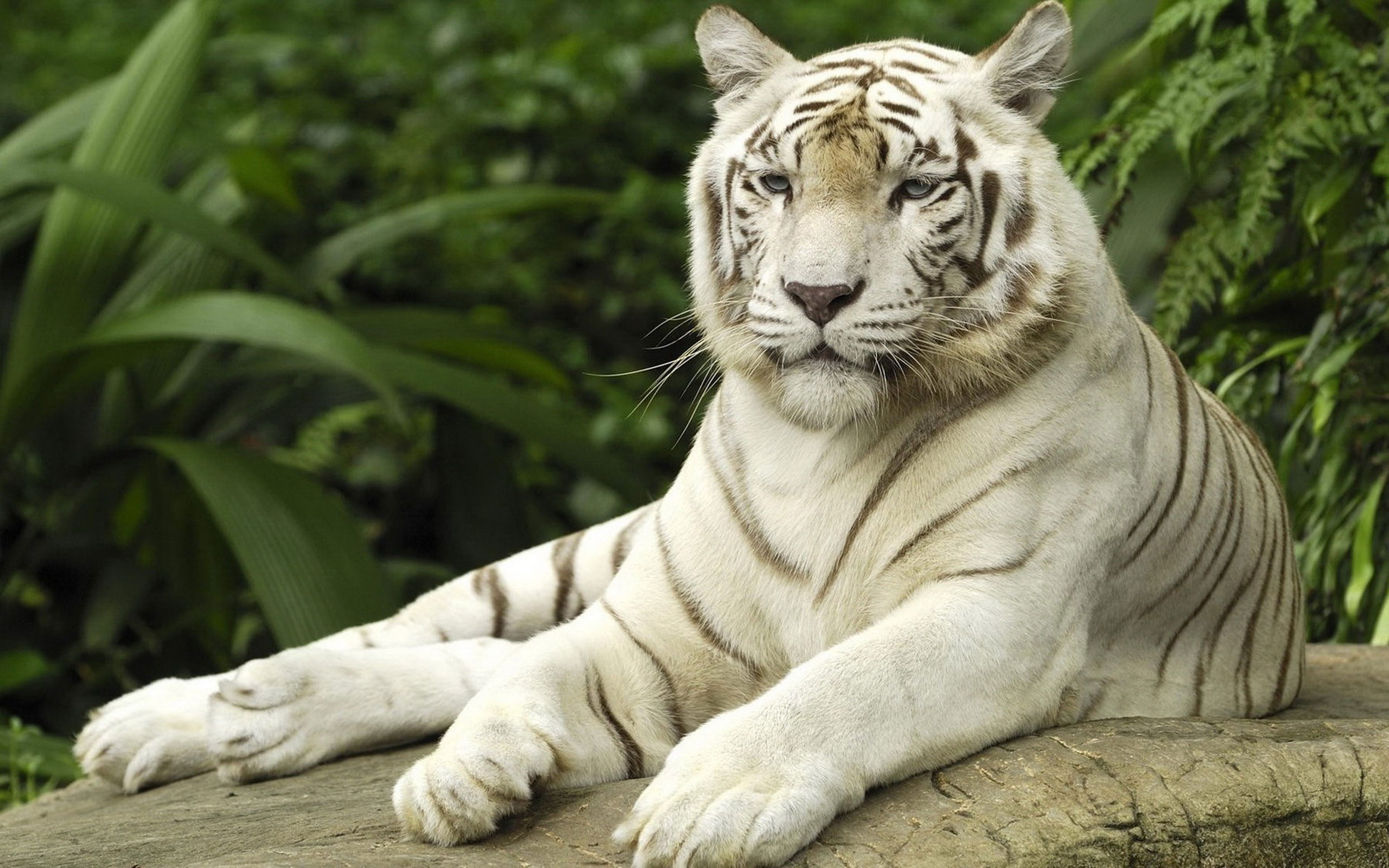
Further information: Reintroduction and Siberian Tiger Re-population Project
Inspired by findings that the Amur tiger is the closest relative of
the Caspian tiger, there has been discussion whether the Amur tiger
could be an appropriate subspecies for reintroduction into a safe place
in Central Asia. The Amu-Darya
Delta was suggested as a potential site for such a project. A
feasibility study was initiated to investigate if the area is suitable
and if such an initiative would receive support from relevant decision
makers. A viable tiger population of about 100 animals would require at
least 5000 km2 (1930 sq mi) of large tracts of contiguous
habitat with rich prey populations. Such habitat is not presently
available in the Delta, and so cannot be provided in the short term. The
proposed region is therefore unsuitable for the reintroduction, at
least at this stage of development.[53]A second possible introduction site in Kazakhstan is the Ili River delta at the southern edge of Lake Balkhash. The delta is situated between the Saryesik-Atyrau Desert and the Taukum Desert and forms a large wetland of about 8000 square kilometres. Until 1948, the delta was a refuge of the extinct Caspian tiger. Reintroduction of the Siberian tiger to the delta has been proposed. Large populations of wild boar, which were a main prey base of the Turan tiger, can be still found in the swamps of the delta. The reintroduction of the Buchara deer, which was once an important prey item is under consideration. The Ili delta is therefore considered as a suitable site for introduction.[54]
In 2010, Russia exchanged two captive Amur tigers for Persian leopards with the Iranian government, as conservation groups of both countries agreed on reintroducing these animals into the wild within the next five years. This issue is controversial since only 30% of such releases have been successful, and introducing exotic species into a new habitat can inflict irreversible and unknown damage.[55] In December 2010, one of the tigers exchanged died in Eram Zoo in Tehran.[56]
Future re-introduction is planned as part of the rewilding project at Pleistocene Park in the Kolyma river basin in northern Yakutia (Russia), providing the population of herbivores has reached a size warranting the introduction of large predators.[57][58][59]
In captivity
Siberian tigress with cub in captivity
Siberian Tiger at Colchester Zoo
In recent years, captive breeding of tigers in China has accelerated to the point where the captive population of several tiger subspecies exceeds 4,000 animals. Three thousand specimens are reportedly held by 10–20 "significant" facilities, with the remainder scattered among some 200 facilities. This makes China home to the second largest captive tiger population in the world, after the US, which in 2005 had an estimated 4,692 captive tigers.[60] In a census conducted by the US based Feline Conservation Federation, 2,884 tigers were documented as residing in 468 American facilities.[61]
In 1986, the Chinese government established the world's largest Siberian tiger breeding base "Heilongjiang Northeast Tiger Forest Park (黑龙江东北虎林园)"[62] and was meant to build a Siberian tiger gene pool to ensure the genetic diversity of Siberian tigers. Liu Dan, Chief Engineer of the Heilongjiang Northeast Tiger Forest Park, introduced a measure such that the Park and its existing tiger population would be further divided into two parts, one as the protective species for genetic management and the other as the ornamental species. It was discovered that when the Heilongjiang Northeast Tiger Forest Park was founded it had only 8 tigers, but according to the current breeding rate of tigers at the park, the worldwide number of wild Siberian tigers will break through 1,000 in late 2010.[63]
South Korea expected to receive three tigers pledged for donation in 2009 by Russia in 2011.[64][65] South Korea may be able to rebuild a home for Siberian tigers.[66]
Genetic research
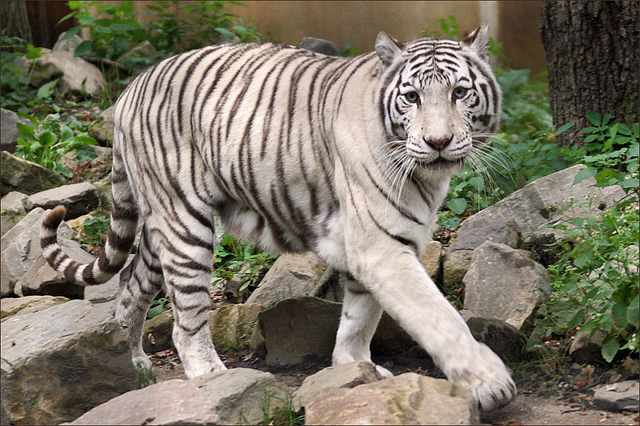
Several reports have been published since the 1990s on the genetic makeup of the Siberian tiger and its relationship to other subspecies. One of the most important outcomes has been the discovery of low genetic variability in the wild population, especially when it comes to maternal or mitochondrial DNA lineages.[67] It seems that a single mtDNA haplotype almost completely dominates the maternal lineages of wild Siberian tigers. On the other hand, captive tigers appear to show higher mtDNA diversity. This may suggest that the subspecies has experienced a very recent genetic bottleneck caused by human pressure, with the founders of the captive population being captured when genetic variability was higher in the wild.[68][69]
Around the start of the 21st century, researchers from the University of Oxford, the U.S. National Cancer Institute and the Hebrew University of Jerusalem collected tissue samples from 23 Caspian tiger specimens kept in museums across Eurasia. They sequenced at least one segment of five mitochondrial genes, and observed a low amount of variability of the mitochondrial DNA in P. t. virgata as compared to other tiger subspecies. They re-assessed the phylogenetic relationships of tiger subspecies and observed a remarkable similarity between Caspian and Amur tiger indicating that the Amur tiger population is genetically the closest living relative of the extinct Caspian tiger, and strongly implying a very recent common ancestry for the two groups. Based on phylogeographic analysis they suggested that the ancestor of Caspian and Amur tigers colonized Central Asia via the Gansu−Silk Road region from eastern China less than 10,000 years ago, and subsequently traversed Siberia eastward to establish the Amur tiger in the Russian Far East. The actions of industrial age humans may have been the critical factor in the reciprocal isolation of Caspian and Amur tigers from what was likely a single contiguous population.[9]
Samples of 95 wild Amur tigers were collected throughout their native range to investigate questions relative to population genetic structure and demographic history. Additionally, targeted individuals from the North American ex situ population were sampled to assess the genetic representation found in captivity. Population genetic and Bayesian structure analyses clearly identified two populations separated by a development corridor in Russia. Despite their well-documented 20th century decline, the researchers failed to find evidence of a recent population bottleneck, although genetic signatures of a historical contraction were detected. This disparity in signal may be due to several reasons, including historical paucity in population genetic variation associated with postglacial colonization and potential gene flow from a now extirpated Chinese population. The extent and distribution of genetic variation in captive and wild populations were similar, yet gene variants persisted ex situ that were lost in situ. Overall, their results indicate the need to secure ecological connectivity between the two Russian populations to minimize loss of genetic diversity and overall susceptibility to stochastic events, and support a previous study suggesting that the captive population may be a reservoir of gene variants lost in situ.[46]
Managers will be able to selectively breed to help preserve the unique and rare gene variants. This variation may be used to re-infuse the wild population sometime in the future if reintroduction strategies are deemed warranted.[70]
In 2013 the whole genome of the Siberian tiger was sequenced and published.[71]
Attacks on humans
See also: Tiger attack
A "Beware of Tigers" sign In Russian
According to the Japanese Police Bureau in Korea, a tiger killed only one human, whereas leopards killed three, wild boars four and wolves 48 in 1928.[72] Only six cases were recorded in 20th century Russia of unprovoked attacks leading to man-eating behaviour. Provoked attacks are however more common, usually the result of botched attempts at capturing them.[26]
In December 1997, an injured Amur tiger attacked, killed and consumed two people. Both attacks occurred in the Bikin River valley. The anti-poaching task force Inspection Tiger investigated both deaths, tracked down and killed the tiger.[73]
In January 2002, a man was attacked by a Siberian tiger on a remote mountain road near Hunchun in Jilin Province, China, near the borders of Russia and North Korea. He suffered compound fractures but managed to survive. When he sought medical attention, his story raised suspicions as Siberian tigers seldom attack humans. An investigation of the attack scene revealed that raw venison carried by the man was left untouched by the tiger. Officials suspected the man to be a poacher who provoked the attack.[74] The following morning, tiger sightings were reported by locals along the same road, and a local TV station did an on-site coverage. The group found tiger tracks and blood spoor in the snow at the attack scene and followed them for approximately 2,500 meters, hoping to catch a glimpse of the animal. Soon, the tiger was seen ambling slowly ahead of them. As the team tried to get closer for a better camera view, the tiger suddenly turned and charged, causing the four to flee in panic.[75] About an hour after that encounter, the tiger attacked and killed a 26-year-old woman on the same road.[76] Authorities retrieved the body with the help of a bulldozer. By then, the tiger was found lying 20 meters away, weak and barely alive.[77] It was successfully tranquilized and taken for examination, which revealed that the tiger was anemic and gravely injured by a poacher’s snare around its neck, with the steel wire cutting deeply down to the vertebrae, severing both trachea and esophagus. Despite extensive surgery by a team of veterinarians, the tiger died of wound infection.[78][79] Subsequent investigation of the first attack revealed that the first victim was a poacher who set multiple snares that caught both the tiger and a deer.[80] The man was later charged for poaching and harming endangered species. He served two years in prison.[81] After being released from prison, he worked in clearing the forest of old snares.[82]
In an incident at the San Francisco Zoo in December 2007, a Siberian tiger escaped and killed a visitor, and injured two others. The animal was shot by the police. The zoo was widely criticized for maintaining only a 12.5 ft (3.8 m) fence around the tiger enclosure, while the international standard is 16 ft (4.9 m). The zoo subsequently erected a taller barrier topped by an electric fence. One of the victims admitted to taunting the animal.[83]
Zookeepers in the Chinese provinces of Anhui, Shanghai, and Shenzhen respectively, were attacked and killed in 2010.[84]
In January 2011, a Siberian tiger attacked and killed a tour bus driver at a breeding park in the northern province of Heilongjiang, China. Park officials reported that the bus driver violated safety guidelines by leaving the vehicle to check on the condition of the bus.[85]
In September 2013, a Siberian tiger mauled a zookeeper to death at a zoo in western Germany after the worker forgot to lock a cage door during feeding time.[86]
In culture
A Siberian tiger in the heraldic arms of the Jewish Autonomous Oblast in Russia.
- The Tungusic people considered the Siberian tiger a near-deity and often referred to it as "Grandfather" or "Old man". The Udege and Nanai called it "Amba". The Manchu considered the Siberian tiger as Hu Lin, the king.[26] The most elite unit of the Chinese Imperial Army in the Manchu Qing Dynasty was called "Hu Shen Ying", literally "The Tiger God Battalion".
- Hodori, the mascot of the 1988 Summer Olympics in Seoul, South Korea, is a Siberian tiger.
- Vitaly, one of the supporting characters in the 2012 DreamWorks Animation film Madagascar 3: Europe's Most Wanted is a Siberian tiger who speaks with a Russian accent.
- The Siberian tiger is used as a charge in heraldry and is the national animal of Korea.




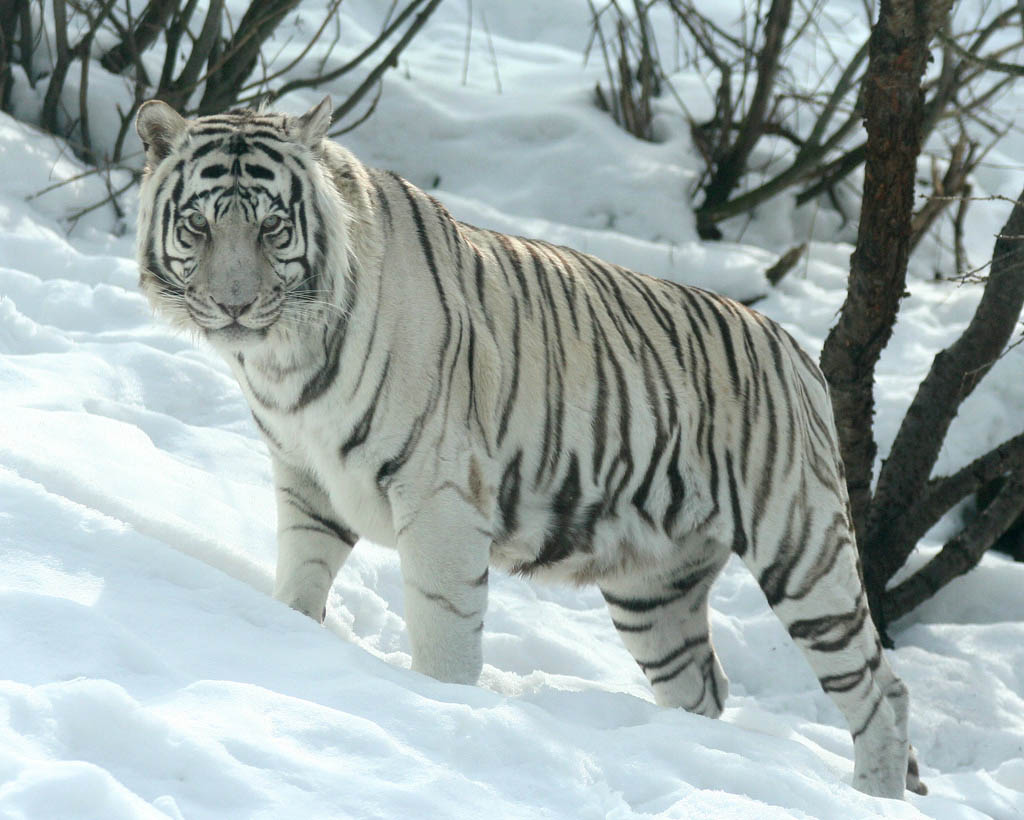







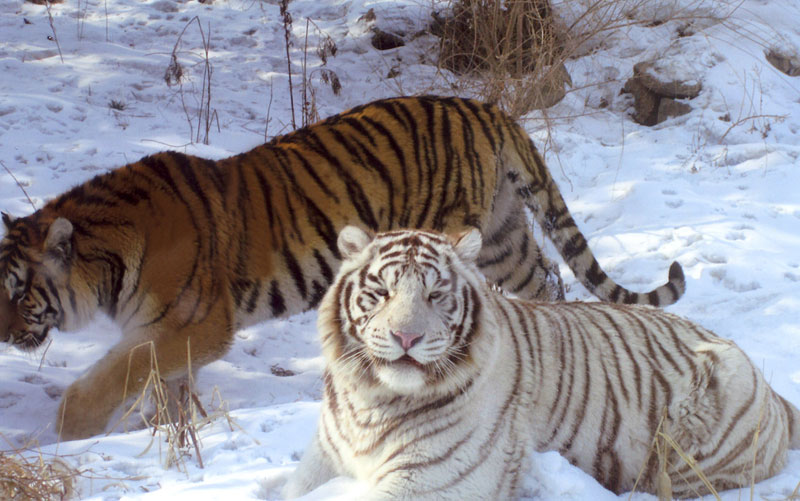



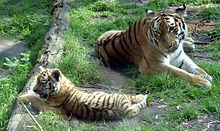

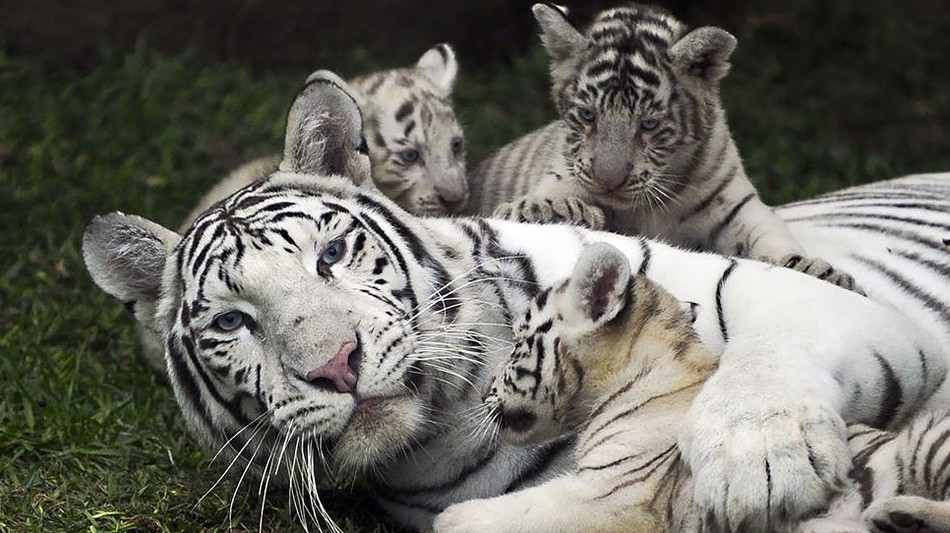



No comments:
Post a Comment
Note: Only a member of this blog may post a comment.